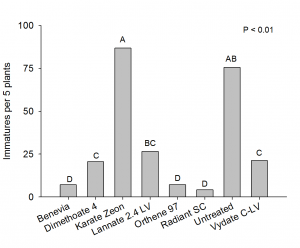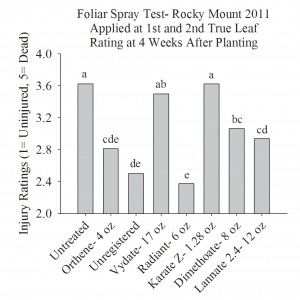Alternatives to Acephate for Thrips and Dealing With Lackluster Management
go.ncsu.edu/readext?300519
en Español / em Português
El inglés es el idioma de control de esta página. En la medida en que haya algún conflicto entre la traducción al inglés y la traducción, el inglés prevalece.
Al hacer clic en el enlace de traducción se activa un servicio de traducción gratuito para convertir la página al español. Al igual que con cualquier traducción por Internet, la conversión no es sensible al contexto y puede que no traduzca el texto en su significado original. NC State Extension no garantiza la exactitud del texto traducido. Por favor, tenga en cuenta que algunas aplicaciones y/o servicios pueden no funcionar como se espera cuando se traducen.
Português
Inglês é o idioma de controle desta página. Na medida que haja algum conflito entre o texto original em Inglês e a tradução, o Inglês prevalece.
Ao clicar no link de tradução, um serviço gratuito de tradução será ativado para converter a página para o Português. Como em qualquer tradução pela internet, a conversão não é sensivel ao contexto e pode não ocorrer a tradução para o significado orginal. O serviço de Extensão da Carolina do Norte (NC State Extension) não garante a exatidão do texto traduzido. Por favor, observe que algumas funções ou serviços podem não funcionar como esperado após a tradução.
English
English is the controlling language of this page. To the extent there is any conflict between the English text and the translation, English controls.
Clicking on the translation link activates a free translation service to convert the page to Spanish. As with any Internet translation, the conversion is not context-sensitive and may not translate the text to its original meaning. NC State Extension does not guarantee the accuracy of the translated text. Please note that some applications and/or services may not function as expected when translated.
Collapse ▲I’ve been fielding a lot of calls concerning the effectiveness of acephate for thrips. Remember that our seed treatments run out at 2-3 weeks after planting (probably closer to two) and we are relying pretty heavily on our sprays. In my opinion, a spray of acephate is still the best option to manage thrips once the seed treatment runs out given its effectiveness and price. Pyrethroids (including bifenthrin) are not effective and other chemicals are generally not as effective. One exception is 3 oz of Radiant plus a surfactant, covered in this article. In previous screening trials, this has been as effective on tobacco thrips as acephate.

Immature thrips averaged from foliar tests across the Southeast in 2011. Note that Benevia is an unregistered chemical and that Radiant was sprayed at 6 oz/A, versus the N.C. Cooperative Extension recommendation of 3 oz + surfactant. Source: Mike Toews, Univ. of GA.

Note that Benevia is an unregistered chemical and that Radiant was sprayed at 6 oz/A, versus the N.C. Cooperative Extension recommendation of 3 oz + surfactant.
Other folks have been concerned about lackluster performance of foliar sprays. The most important thing to look for is the presence of live thrips after your spray. Do you have immatures present? Adults? Immatures might be Western flower thrips (again, covered in this article in this article), so consider using Radiant or spraying up to 1 lb. active ingredient of acephate. In this dry weather, you might see some flaring of other pests, such as spider mites behind acephate. Radiant is a much softer chemical and will not flare other pests. Neither chemical will have much residual so we might expect that adults could move in behind the sprays. In this case, your field may simply require a respray if immatures develop from these colonizers. If you are seeing dinged up plants, but no thrips present, you could be seeing injury that happened before your spray or you could be seeing some herbicide injury that only mimics thrips injury (see a good article on this). Finally, keep in mind that a good rain will help our cotton jump out of the injury that they are experiencing now.


